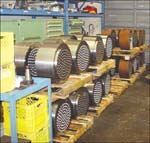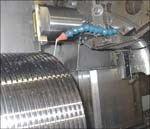Unusual Function For Groove And Turn System
Although this tooling was engineered for turn, face, profile, OD and ID groove, bore and cutoff applications, it is used in 95 percent of the company's threading functions in which large OD square threads are required.
Established in 1999 by Josef and Susan Kaltenegger, their two sons, Hans and Jeff, and son-in-law Nico Morowat, Kaltech Manufacturing (Delta, British Columbia) specializes in white-iron machining and contracts with other job shops that require versatility. To remain competitive in the fabrication and machinery industry, the company uses A4 tooling from Kennametal (Latrobe, Pennsylvania).
The company uses the A4 groove and turn system for primary roughing to reduce the time needed to finish a large-diameter thread. The bulk of the material is removed before finish passes are made with the threading insert. Although the tooling was engineered for turn, face, profile, OD and ID groove, bore and cutoff applications, it is used in 95 percent of the company's threading functions in which large OD square threads are required.
"The tooling enables our machinists to precut the course thread on large bolts," says Hans Kaltenegger, operations manager at Kaltech. "Contact Systems, our principal customer, uses the bolts we thread to secure large cables on hydroelectric dams," he explains.
The tooling is rigid enough to withstand the task of threading the OD of the cable-tightening bolts. This application requires the company's machinery to remove a large amount of material (the trapezoidal thread on this large steel bolt is 46 mm by 14 mm).
The shop needed a dependable tool that could rough out the entire piece and then finish the bottom or root. Kennametal Metalcutting Systems Engineer Ron Christiaens recommended the A4 because of its rigidity and depth-of-cut capability.
"At the time, we were ordering an insert from Sweden, and it just wasn't convenient or cost-effective," Mr. Kaltenegger recalls. "After talking with Mr. Christiaens, we decided to follow his advice. The tooling performed above and beyond what it was supposed to." According to Mr. Kaltenegger, the excessive overhang normally makes such a job impossible; however, the A4 tooling removed the bulk of the material and made it possible to complete the job with a light finish pass of the threading insert.
The tool was pushed beyond its average range to accommodate the thread feed of 50 ipm (88 rpm), and the company's machinists are now threading eight pieces per A4 edge, which assists in reducing production time by 70 percent.
Kaltech machined a total of 50 bolts for Contact Systems, and it estimates that the tooling saved Kaltech roughly 25 percent in costs—approximately 20 percent per part in labor costs and $300 per part in insert costs.
Because the tooling had been designed for high productivity on machines with limited tool positions, the company has found it to be especially valuable in operations. Kaltech machines a large amount of material on CNC lathes, so it's inconvenient for a machinist to stop production and change the insert. The double-ended A4 has four cutting edges, so the workload can be divided using one tool.
In addition to rigidity, the company has found that the tooling provides stable cutting capability and can allow better insert indexability than single-ended inserts. The secure clamping and bottom-V seating surface enable high feed rates and improved depth-of-cuts. The customized design can also eliminate side deflection and extend the life of the tool.
"The bolts are machined from large amounts of material, so we often have considerable overhang, which usually causes chatter," Mr. Kaltenegger explains. "However, chatter is minimized using the new tools."
With immediate customer demands, Kaltech cannot afford to stock specialized tools and cannot wait for tools to be ordered and delivered. Being able to perform several functions with one tool is convenient and also allows for quick cycle times and no turret indexes.
"We have two shifts, so the A4 tool is often left out on the shop floor," Mr. Kaltenegger says. "It moves around quite a bit, and if there's an application where it can be used, the workers use it."
The shop says it also uses the tools for machining tough and abrasive materials such as high-chrome steel products. It can groove the white iron, and the tooling withstands the extreme temperatures.
Read Next
3 Mistakes That Cause CNC Programs to Fail
Despite enhancements to manufacturing technology, there are still issues today that can cause programs to fail. These failures can cause lost time, scrapped parts, damaged machines and even injured operators.
Read MoreThe Cut Scene: The Finer Details of Large-Format Machining
Small details and features can have an outsized impact on large parts, such as Barbco’s collapsible utility drill head.
Read More








.png;maxWidth=300;quality=90)













